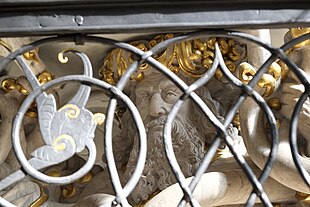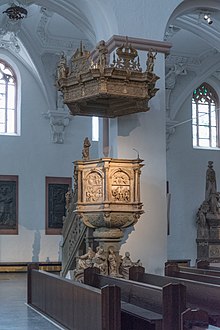Michael Kern (sculptor)
Michael Kern (also Michael III. Kern ; born August 23, 1580 in Forchtenberg ; † August 31, 1649 ibid) was an important sculptor from the Kern family of artists at the transition from the Renaissance to the Baroque . As a sculptor for the prince-bishop of Würzburg and as court sculptor for the Counts of Hohenlohe , he created some outstanding works.
Life
Youth and Education (until 1607)
Michael Kern was born as the first child of the older Michael Kern in the district of Forchtenberg of the Counts of Hohenlohe-Weikersheim. The father had already worked as a sculptor and stonemason in the village and made his appearance by building some bridges and fortifications. His mother, Apollonia Kern, née Hartmann, gave birth to a total of seven children, of whom the brothers Georg, Leonhard and Peter were also to become important sculptors.
The family lived in the house at Hafenmarktgasse 29, which was located within the city walls on the Kocher . In contrast to his younger brother Leonhard, there is no written proof of school education for Michael, but since he was able to write, an at least basic school career is likely. In the years 1593 to 1596 Michael then visited his father's workshop and learned the basics of sculpture here.
On November 30, 1597, Michael Kern was sent to nearby Heilbronn to do another apprenticeship with the sculptor and builder Jakob Müller . During his training, Müller was commissioned to rebuild the castle church in Liebenstein . The first traces of the young Michael Kern, who helped his master with his work, can be found in this building. After completing his apprenticeship, Michael traveled around as a journeyman, but individual stations of his wandering are not documented.
Until 1605, however, Klein often stayed in his native town. It was at this point in time that the young sculptor's first independent works can also be identified. In 1603 the tumba of Count Wolfgang II von Hohenlohe-Weikersheim was created , in 1603 it can be traced for the first time on the new building of the Marienberg Fortress in Würzburg , for which he built the Echtertor in 1605. From 1606, Kern had settled in Würzburg, which means that work on the fortress progressed quickly.
In the same year, 1606, Kern married Christina Maij (also Mai) from Würzburg . Due to his collaboration in the reconstruction of the fortress, the St. Luke's Guild of Sculptors waived a proof of work and accepted Michael Kern as a master in their ranks on December 21, 1606. On April 30, 1607, Kern was hired as council sculptor for Würzburg and became a citizen of the episcopal city on Pentecost of the same year .
Court sculptor in Forchtenberg (until 1649)
Nevertheless, he returned to Forchtenberg in 1607. Reasons for this were, on the one hand, the rich deposits of alabaster that could be found below the birth house, on the other hand, Kern was not prepared to change his denomination , he was a Lutheran, because of a move to Catholic Würzburg. In 1610 Michael Kern received a comprehensive tax exemption from Count Wolfgang von Hohenlohe and was appointed court sculptor.
From then on Michael Kern received many orders from the count family. In addition, he worked for the Hochstifte Bamberg and Würzburg , and even accepted work from civil clients. Commissioned by the Würzburg City Council, he built the pulpit of the Würzburg Cathedral from 1609 to 1610 . In 1634 Michael Kern was the third richest resident of Forchtenberg. Two years later, King Ferdinand of Hungary and Bohemia was one of his customers. The success also brought conflicts with the other city residents: In the years before the Thirty Years War, witchcraft accusations against members of the Kern family have even been proven.
The war, which raged between 1630 and 1640 in Hohenlohe Franconia, significantly reduced Kern's orders. Even the sculptor's workshop was destroyed during some fighting. After the warlike invasions of Swedes and imperial forces, epidemics struck the emaciated area around Forchtenberg. Kern's wife Christina died of an unknown disease in 1636.
On February 21, 1642 Michael Kern married again, this time the younger Barbara, née Brackenheimer, from his native town. Michael Kern died on August 31, 1649 in his hometown on the Ruhr and was buried in the cemetery. His tombstone was initially in the cemetery wall and is now kept in the Kern Museum. After the father's death, the second son, Achilles, continued the workshop.
Works (selection)
Michael Kern initially worked primarily for the Würzburg Prince-Bishop Julius Echter von Mespelbrunn , among other things on the rebuilding of the Marienberg Fortress in Würzburg. After 1607, Kern moved his main focus to the County of Hohenlohe. He made many epitaphs and high graves for the count family, but at the same time continued to work in the spiritual territories of the area.
- 1609/1610: Pulpit in the Würzburg Kilians Cathedral
- shortly before 1609 or 1611: Alabaster altar in the house chapel of the Conti Curia , a canon court in Würzburg (today the Episcopal Palace)
- 1610/1611: Epitaphs for the prince-bishops of Bamberg, Neidhardt von Thüngen and Johann Philipp von Gebsattel
- 1611: Statues of fourteen helpers in the Gügelkirche
- 1614/18 Baldachin tomb for Count and Countess von Löwenstein - Wertheim in Protestant collegiate church in Wertheim
- 1612/1613: Portal of the pilgrimage church Maria im Sand
- 1619/1620: Epitaph Count Friedrich Magnus zu Erbach, Michelstadt parish church
- 1621: Wappenstein Monastery Schöntal
- 1623: Epitaph for Prince-Bishop Johann Gottfried I von Aschhausen and tomb for General Jakob Baur von Eiseneck
- 1626: Wurzel-Jesse-Pulpit pilgrimage church Maria im Sand
- 1627: Höchberg group of crucifixions
- 1627/1628: Epitaph Count Johann Casimir zu Erbach, Michelstadt parish church
- 1644: Cross altar of Schöntal Monastery
literature
- Walter Rößler: The Kern family of artists. Craftsmen, builders, sculptors. In: Stadt Forchtenberg (ed.): The artist family Kern 1529–1691. Hohenloher sculptor and builder of the baroque. Thorbecke, Sigmaringen 1998, ISBN 3-7995-0123-1 , pp. 25-27.
- Vera Schneider: Michael Kern III. The sculptor von Forchtenberg 1580–1649. In: Stadt Forchtenberg (ed.): The artist family Kern 1529–1691. Hohenloher sculptor and builder of the baroque. Thorbecke, Sigmaringen 1998, ISBN 3-7995-0123-1 , pp. 33-101.
- Vera Schneider: Michael Kern (1580–1649). Life and work of a German sculptor between Renaissance and Baroque (= research from Württembergisch-Franken. Volume 49). Thorbecke, Ostfildern 2003, ISBN 3-7995-7650-9 .
- Church council of the Evangelical City Church Community of Michelstadt (ed.): Evangelical City Church Michelstadt. With contributions by Christiane Backöfer, Dr. Martin Balz, Heidi Banse, Claus-Eckart Fricke, Edina Silber Bonz. Michelstadt 2014.
- Judith Breuer: The tomb of Count Ludwig von Löwenstein-Wertheim and his wife Anna in the collegiate church of Wertheim. The cultural and art historical significance of the tomb. In: Preservation of monuments in Baden-Württemberg. News bulletin of the state monument preservation. Volume 45, No. 2, 2016, pp. 97-103.
- Frank Eger, Otto Wölbert: Permanently preserved again after the danger of collapse: the Wertheim 'bed drawer'. Documentation, preliminary investigation and measures on the alabaster artwork. In: Preservation of monuments in Baden-Württemberg. News bulletin of the state monument preservation. Volume 45, No. 2, 2016, pp. 104-109.
Web links
Individual evidence
- ^ German digital library: Michael Kern .
- ↑ Vera Schneider: Michael Kern III. The sculptor from Forchtenberg. P. 33.
- ↑ Vera Schneider: Michael Kern. P. 12.
- ↑ Stefan Kummer : Architecture and fine arts from the beginnings of the Renaissance to the end of the Baroque. In: Ulrich Wagner (Hrsg.): History of the city of Würzburg. 4 volumes; Volume 2: From the Peasants' War in 1525 to the transition to the Kingdom of Bavaria in 1814. Theiss, Stuttgart 2004, ISBN 3-8062-1477-8 , pp. 576–678 and 942–952, here: pp. 603 f.
- ↑ Vera Schneider: Michael Kern III. The sculptor from Forchtenberg. P. 41.
- ↑ Stefan Kummer: Architecture and fine arts from the beginnings of the Renaissance to the end of the Baroque. 2004, p. 603 f.
- ↑ Evangelical town church Michelstadt. P. 23f. and 39.
- ↑ Stefan Kummer: Architecture and fine arts from the beginnings of the Renaissance to the end of the Baroque. 2004, p. 610.
- ↑ Evangelical town church Michelstadt. P. 25f. and 37f.
- ↑ Vera Schneider: Michael Kern. P. 41 ff.
| personal data | |
|---|---|
| SURNAME | Kern, Michael |
| ALTERNATIVE NAMES | Kern, Michael III. |
| BRIEF DESCRIPTION | sculptor |
| DATE OF BIRTH | August 23, 1580 |
| PLACE OF BIRTH | Forchtenberg |
| DATE OF DEATH | August 31, 1649 |
| Place of death | Forchtenberg |




